Welcome back to the final installment of our Deep(er) Drive, where we tell the long and fascinating story of public transit in Pinellas County.
Spoiler alert: If you haven’t read part 1 and part 2, yet, we highly recommend giving those a read first!
Last episode, we covered a lot of ground from the Roaring Twenties to the great merger of the 80s. The early era of the bus was fraught with many funding challenges as the United States government slowly established its role in funding mass transit projects.
But now, with the existence of the Urban Mass Transportation Administration (UMTA) (now called the Federal Transit Administration or FTA), the creation of federal grants, and approval for local funding, our favorite new transit system would have a much less bumpy ride ahead.
Let’s see what this new era of PSTA has in store for us!
Welcome, Pinellas Suncoast Transit Authority
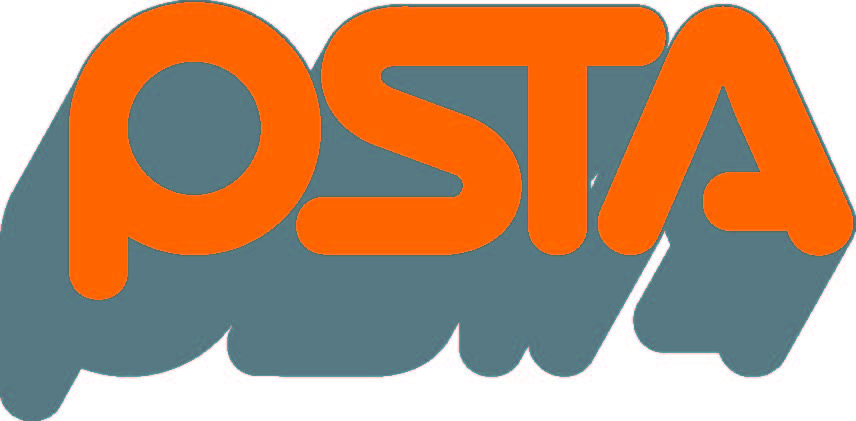
The original 1984 PSTA logo and colors, clearly inspired by the previous CPTA logo.
(PSTA Archives)
Boasting 128 buses on 79 routes, PSTA now served all of Pinellas County, with the exception of a few beach communities that had chosen not to vote in the referendum. The changes were immediate but somewhat subtle for the general public.
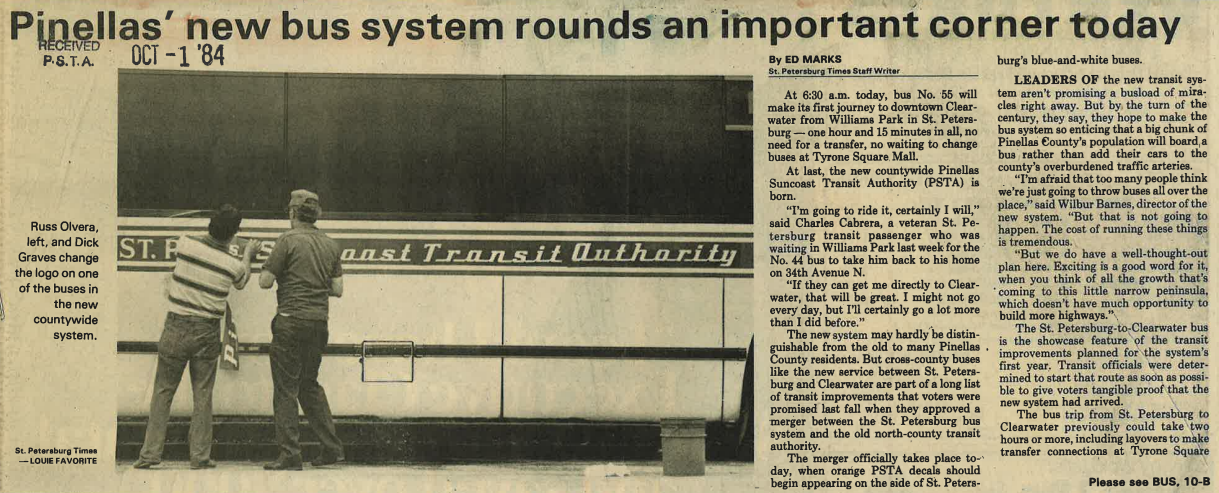 A St. Petersburg Times article discussing the merger, featuring a photo of a PSTA decal being placed over the SPMTS decal.
A St. Petersburg Times article discussing the merger, featuring a photo of a PSTA decal being placed over the SPMTS decal.
(PSTA Archives)
Riders could now reach destinations old and new in far less time. The bus operator shirts changed from blue to white, PSTA logos were placed over the old SPMTS logos, orange and red colors were added to buses as each vehicle was brought in for maintenance. A new jingle with the lyrics “Pinellas, we’ve got you covered. PSTA, from the Gulf to Bay,” was hitting the airwaves, and newspaper and billboard ads encouraged people to try out the new expanded service.
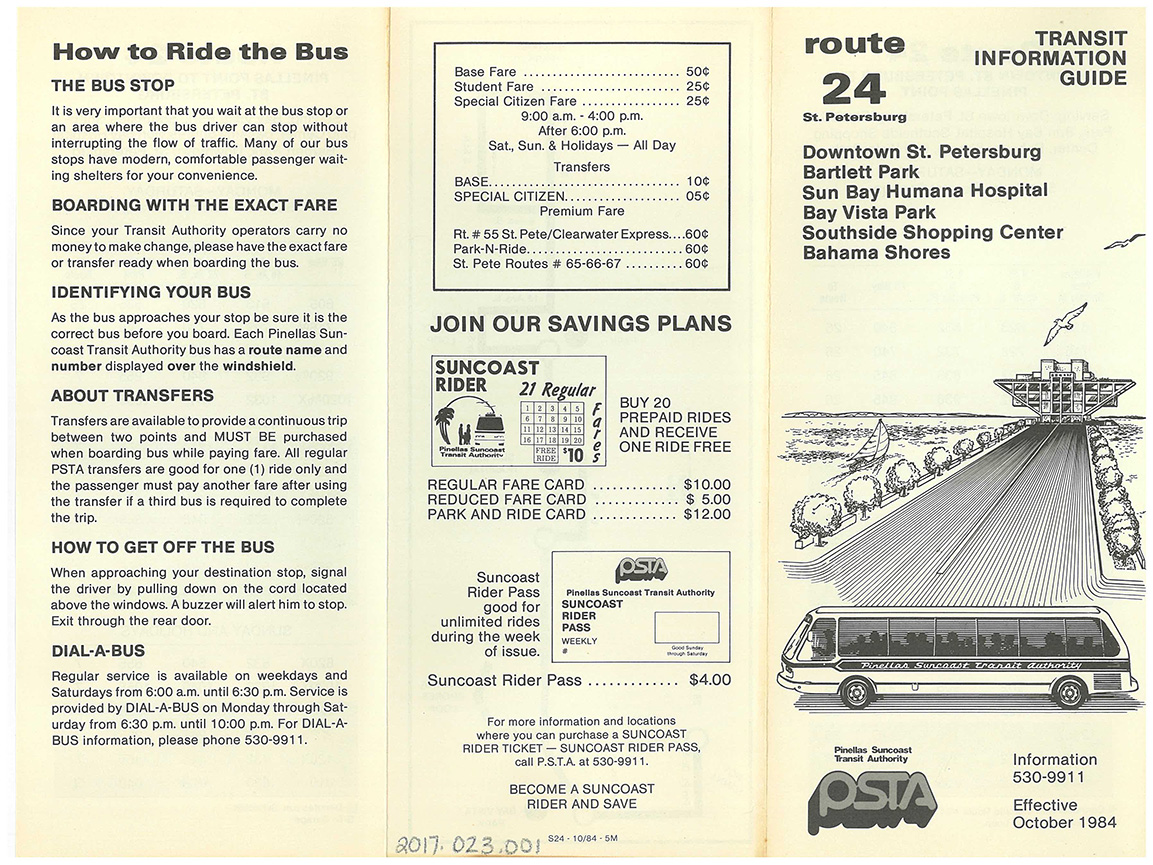 One of the first schedules with the new PSTA branding.
One of the first schedules with the new PSTA branding.
(Courtesy of the St. Petersburg Museum of History)
The two different labor unions of CPTA and SPMTS were not particularly excited about the merger, fearing that it would only lead to labor relations issues. Fare increases were an inevitable reality, as PSTA needed a South Division operations facility to maintain the fleet of over 160 buses it had inherited from SPMTS.
Throughout the 80s, PSTA would unveil many improvements to the system.
1986’s Share-A-Ride program, in collaboration with the Florida Department of Transportation and the Pinellas County Planning Department, would provide designated parking lots around Pinellas where commuters could park and take the bus to work. PSTA would become Florida’s first computerized bus system with the installation of electronic fareboxes between 1977 and 1988. In 1988, the long-awaited St. Petersburg operations/maintenance facility was completed.
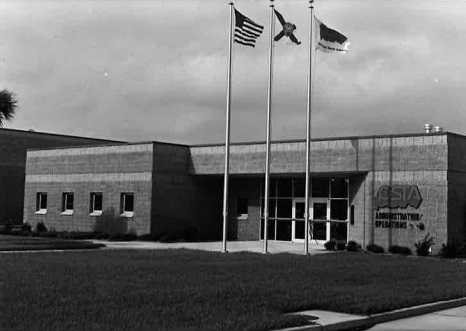 PSTA St. Petersburg Division Operations/Maintenance Facility at 855 28th Street South, c. 1988.
PSTA St. Petersburg Division Operations/Maintenance Facility at 855 28th Street South, c. 1988.
(PSTA Archives)
The new facility would hold 135 administrative and maintenance staff, 14 bus bays, state-of-the-art storage and retrieval for parts, in-ground storage tanks and leak detection systems, and overhead exhaust and dust collection. It’s here that PSTA would run its South County operations into the 90s.
The 1990s
The 1990s saw rapid expansion through new leadership, new initiatives, and new community collaborations. PSTA joined the Pinellas County Sherriff Department’s Neighborhood Crime Watch program. A design competition was held to produce new PSTA bus stop signs. The 70s-era Christmas lights bus tour was brought back. Annual “Roadeos” were held to test bus operator skills, and other transit agencies were invited to compete. Between 1991 and 1994, PSTA purchased 75 new buses, with 1994 marking the completion of the new Williams Park Customer Service Center to replace the original SPMTS information booth from 1950.
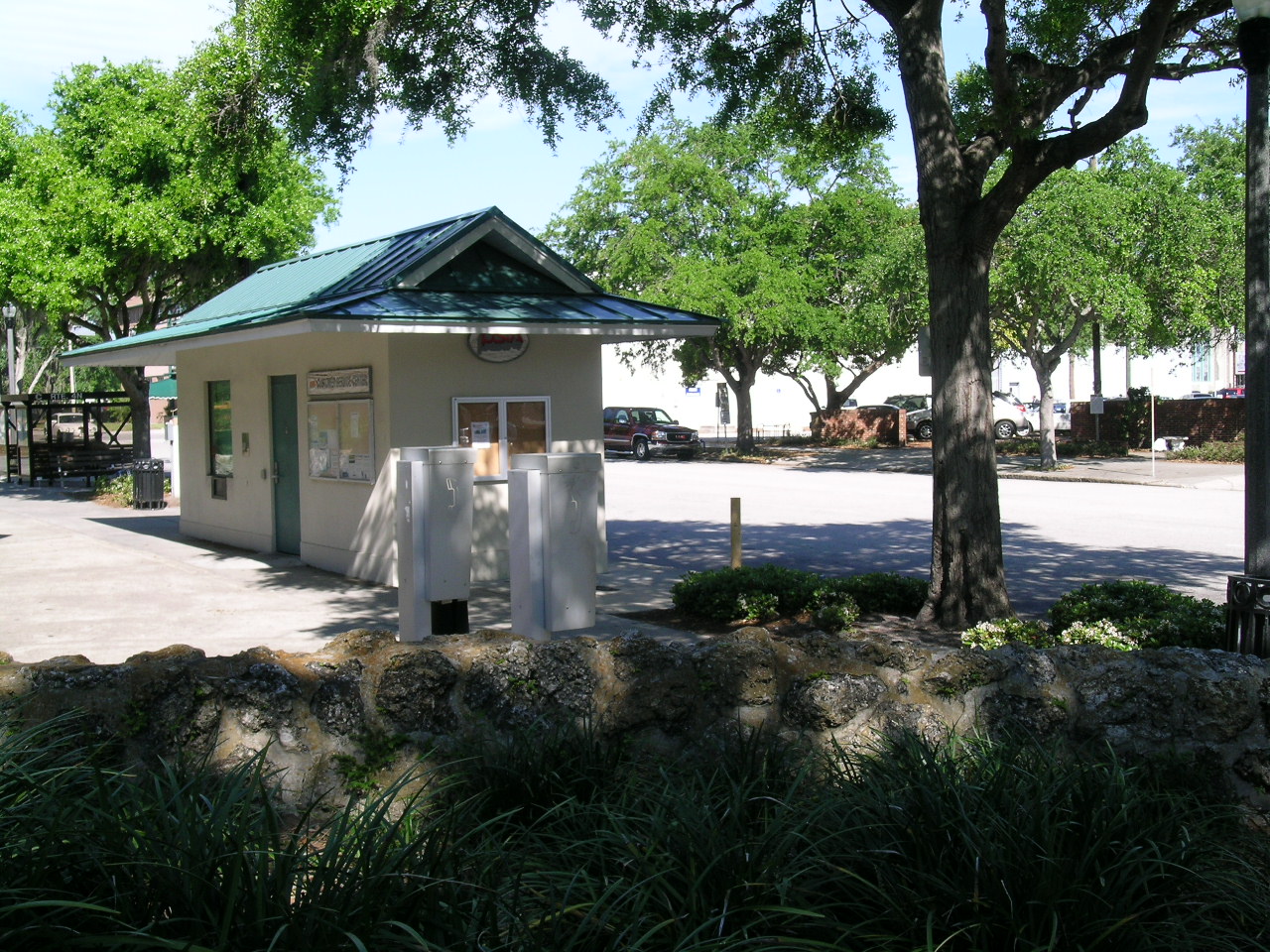 The new Williams Park Information Center, c.1994.
The new Williams Park Information Center, c.1994.
(PSTA Archives)
Route changes arrived as PSTA officially took over Route 100X from Tampa’s agency HART, traveling from St. Petersburg to downtown Tampa via the Gandy Bridge as the agency’s first intra-county service. PSTA also rolled out Route 19, the first service to run the entire length of US 19, carrying 340,000 passengers in its first year.
In 1996, PSTA introduced magnetically encoded “GO cards” for fare payment on all buses. These cards would become the backbone of fare payment throughout the following decades before being phased out in 2024.
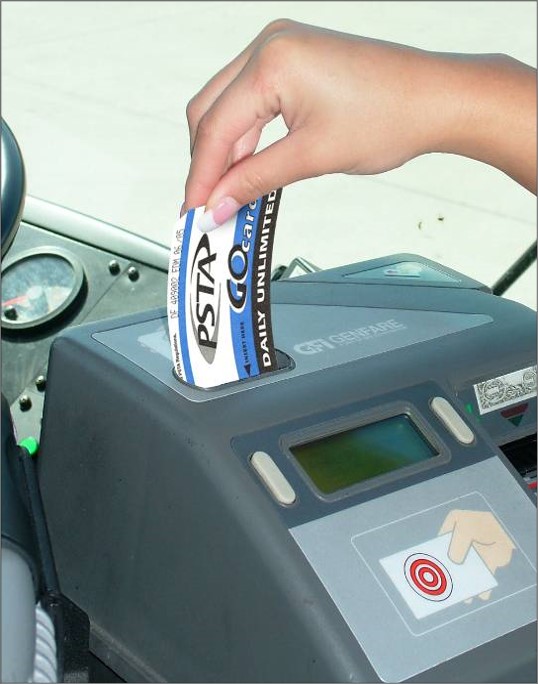 A magnetically encoded GO Card being used for fare payment.
A magnetically encoded GO Card being used for fare payment.
(PSTA Archives)
As the end of the decade approached, PSTA deployed its first low-floor buses with wheelchair ramps in 1996 to improve accessibility for riders, and the agency would carry its 100 millionth passenger in 1997.
The New Millennium
It was the turn of the century and technology would be the name of the game. The new millennium brought huge leaps forward in transit tech, and PSTA worked hard to stay up-to-date with the newest innovations. The decade would bring new services and, most importantly, improved technological features to make transit safer and more convenient.
The 2000s would also herald a new exciting service to the fleet: the Suncoast Beach Trolley. Launching in 2001, the route debuted ten new custom trolleys reminiscent of the streetcars of old and provided the first-ever transit service along the Gulf Coast from Sand Key in Clearwater to St. Pete Beach. A whopping 500,000 people would ride the trolley in its first year of service, proving that beach transit was a huge asset in Pinellas County and its 35 miles of beaches.
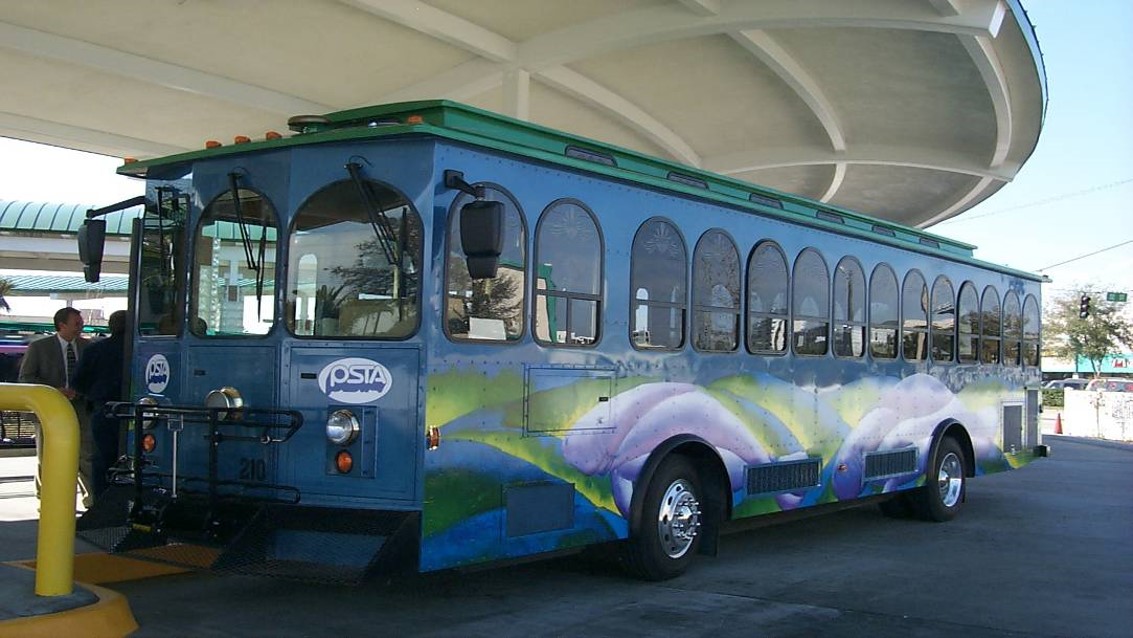 The unveiling of the brand new Suncoast Beach Trolley.
The unveiling of the brand new Suncoast Beach Trolley.
(PSTA Archives)
2001 would also see the addition of new GFI Odyssey electronic fareboxes that included advanced bill recognition technology, as well as the launch of the agency’s website, www.PSTA.net.
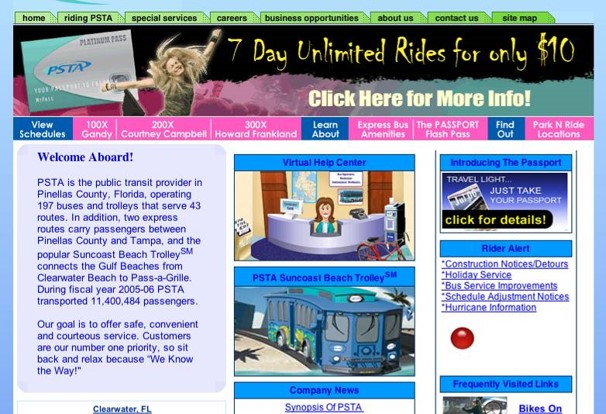 PSTA’s first website homepage, a beautiful example of early 2000s web design.
PSTA’s first website homepage, a beautiful example of early 2000s web design.
(PSTA Archives)
In the following year, PSTA finally opened its anticipated Central Plaza Intermodal Terminal in the Grand Central District of St. Petersburg, renamed “Grand Central Station” in 2009. The new station featured public restrooms, a driver’s break area, dual windows for customer service, and could support up to 12 buses.
 PSTA’s new Central Plaza Intermodal Terminal (renamed Grand Central Station in 2009).
PSTA’s new Central Plaza Intermodal Terminal (renamed Grand Central Station in 2009).
(PSTA Archives)
In addition, the Park Street Terminal would also undergo major rennovations in 2002, with improvements including a new customer service booth and much-needed lot, driveway, and roof repairs. Improvements were also made to the buses as well, with strobing LED brake lights being installed on every bus in the fleet to increase vehicle visibility.
With the help of federal funds, PSTA purchased ten coach-style buses with plush reclining seats for its Route 300X in 2003. The route would provide a comfortable express service from Pinellas to downtown Tampa using the Howard Frankland Bridge. The new buses were also used for the existing Route 100X, another intra-county route that utilized the Gandy Bridge.
This same year, PSTA would break ground on a new Administration, Operations, and Maintenance facility that would combine the Clearwater and St. Petersburg divisions into one centralized headquarters in north St. Pete. Built on a 35-acre plot of land, the complex could accommodate up to 125 administrative personnel, 160 maintenance personnel, 600 bus operators, and 300 buses. By 2005, the new headquarters would be completed and serves as PSTA’s center of operations today.
 The new PSTA headquarters on Scherer Drive in St. Petersburg, right after its completion in 2005.
The new PSTA headquarters on Scherer Drive in St. Petersburg, right after its completion in 2005.
(PSTA Archives)
2004 would be a significant year for PSTA, as the agency celebrated its 20-year anniversary. To honor this milestone, PSTA rolled out an agency-wide rebranding that featured a new logo and bus design. In 2005, PSTA celebrated its Routes 18 and 19 as they were the first to carry one million passengers in a year.
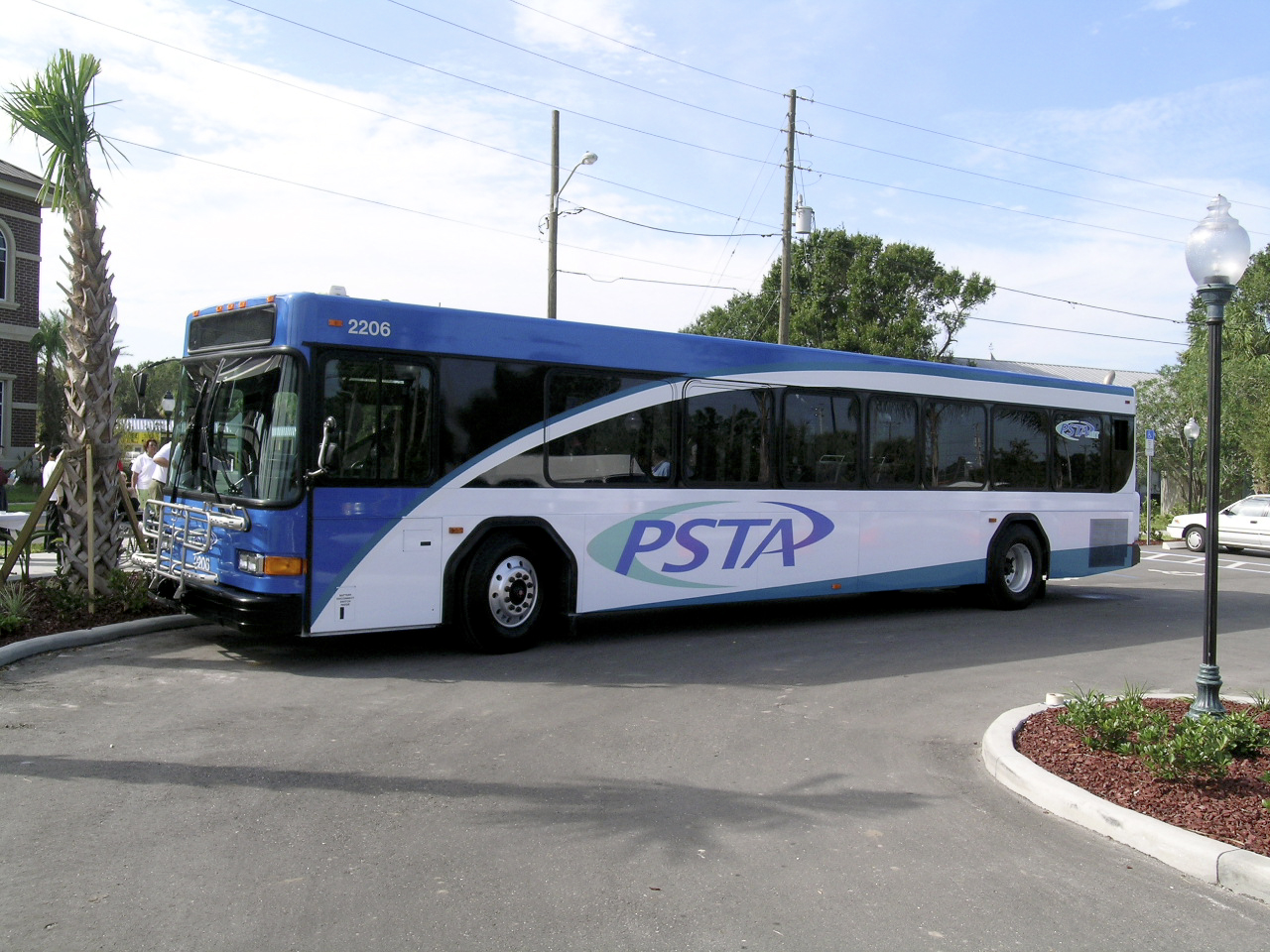 PSTA’s brand-new logo and bus design were revealed in 2004.
PSTA’s brand-new logo and bus design were revealed in 2004.
(PSTA Archives)
2006 would be a big year for fleet and communication improvements, as PSTA received 48 new GILLIG buses to replace the vehicles from 1994 and fully automated its transportation dispatch and scheduling through new software. And the tech improvements continued as the following year saw the release of PSTA’s first website-based trip planner called “Rollin,” which provided detailed step-by-step route directions. However, the service would soon be replaced with the Google-powered transit trip planner, which still exists today.
The last few years of the decade would see continued improvements such as accepting debit and credit cards for the purchase of GO Cards, nine new hybrid SmartBuses to lower vehicle emissions, and a pivotal partnership with the Clearwater Jolley Trolley to service Clearwater Beach, which still exists today.
 PSTA’s first diesel-electric hybrid “SmartBus,” which would operate more quietly, improve fuel economy, and help lower vehicle emissions.
PSTA’s first diesel-electric hybrid “SmartBus,” which would operate more quietly, improve fuel economy, and help lower vehicle emissions.
(PSTA Archives)
However, the last few years of the decade would also mark the housing crash of 2008, resulting in one of the worst recessions in modern history. The financial strain would force PSTA to economize and cut 10% of its services. These difficulties would lead to many discussions around future revenue streams for PSTA, which still remains one of the least-funded transit agencies in the Southeastern United States.
Despite the uncertainty of the recession, PSTA would close out the decade with ridership hitting an all-time record of 13.1 million rides for fiscal year 2009/2010.
The 2010s
The following decade brought with it a huge advancement in technology for PSTA: Real-Time Bus Information. The service would utilize GPS technology and display the exact location of every bus. Such information would be displayed on screens at terminals and visible online through the ridepsta.net site.
 Real Time Bus Information displayed at a bus terminal for riders to track their bus.
Real Time Bus Information displayed at a bus terminal for riders to track their bus.
(PSTA Archives)
2010 would also include the launch of PSTA’s social media accounts, namely Facebook, Twitter, and LinkedIn. Through these platforms, PSTA could finally interact with the public online and notify riders of important route updates, detours, and weather alerts.
During 2010, PSTA also added 14 more diesel-electric hybrid buses, resulting in 24 total hybrid vehicles in the fleet. PSTA’s partner, Jolley Trolley, would introduce a new route running from Clearwater Beach to Downtown Clearwater, Dunedin, Palm Harbor, and Tarpon Springs. It was a first-of-its-kind funding partnership that included contributions from the City of Clearwater’s Downtown Development Board, the City of Dunedin, the City of Tarpon Springs, Pinellas County, and PSTA.
In 2011, PSTA introduced its next new service: the Central Avenue Trolley. Prior to the launch, a rider wishing to get from St. Pete to the beach would’ve had to take three different buses. So, through the combination of the Pier Trolley, the Looper Group’s Central Avenue Shuttle, PSTA’s Route 35, and the Suncoast Beach TrolleySM, the Central Avenue Trolley was born.
The route would offer a streamlined one-seat ride from St. Petersburg Pier to Pass-a-Grille Beach. With the trolley-inspired vehicle design, the Central Avenue Trolley is a loving homage to the original trolley that first rattled down Central Avenue in 1903.
 The Central Avenue Trolley, offering the first Beach to Bay service in 2011.
The Central Avenue Trolley, offering the first Beach to Bay service in 2011.
(PSTA Archives)
PSTA continued to hit ridership records in December 2011, January 2012, April 2012, and June 2012. That same year, the U.S. Department of Homeland Security’s Transportation Security Administration (TSA) recognized PSTA as one of only 17 transit agencies in the nation to earn TSA’s highest rating of “Gold Standard” based on their most recent Baseline Assessment for Security Enhancement (BASE) for their dedication to building a strong security program. The agency would then receive the same award three years in a row, a feat never before achieved by any transit agency.
In May 2012, the agency also earned a perfect score in the Federal Triennial Review by demonstrating perfect compliance to federal auditors in more than 300 areas.
However, the 2010s wouldn’t be all wins for PSTA.
During the 2010s, PSTA embarked on its first effort to increase its funding after years of planning, community outreach, collaboration, and public engagement to improve the system and offer services the community wanted. As one of the most underfunded agencies in the southeast, PSTA wanted to seriously explore the possibility of better funding to leverage the county’s high rate of tourism. As it stood, the agency was still funded through its .75 ad valorem property taxes. However, this meant that only property owners could contribute to PSTA and not the millions of tourists visiting Pinellas yearly.
In 2013, the agency unveiled its Greenlight Pinellas Plan, which proposed a one-cent sales tax to replace its current property tax funding. If the plan passed, it would allow for a 400+% increase in transit service throughout the county, including bus service expansions, later service hours, a light rail service, and new circulator services.
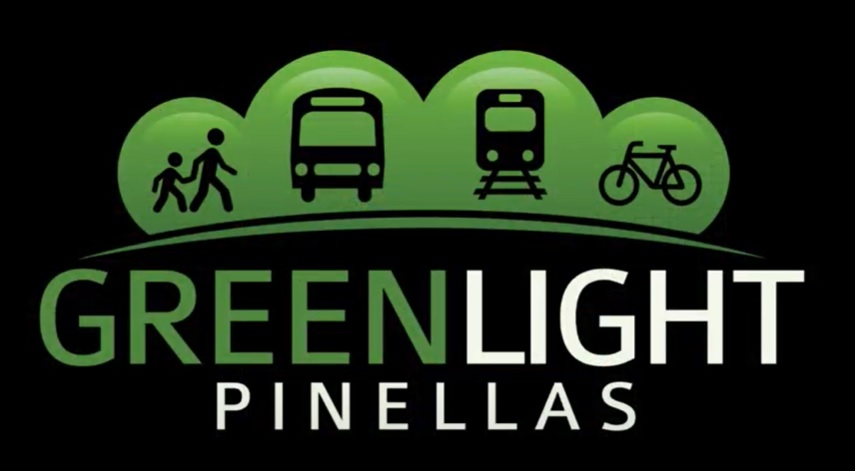 The Greenlight Pinellas Logo.
The Greenlight Pinellas Logo.
(PSTA Archives)
The measure was put on the November 2014 ballot, but the referendum failed.
Without the new robust funding, PSTA’s Planning department faced the difficult reality of funding restrictions and would have no choice but to make many changes to its existing service over the next few years.
Despite the setbacks, PSTA soldiered on to improve services and launch new programs with the funding it had. Ridership continued to grow, reaching an all-time high of 14,898,825. The agency also rolled out its very first partnership with USF St. Pete and the City of St. Petersburg to offer free rides through the brand new Universal Pass or, as it’s known today, UPASS. By showing proof of their enrollment or employment, students and employees from the school and City could enjoy fare-free rides.
Since UPASS’s inception, Pinellas County Schools, St. Petersburg College, Pinellas Technical College, MyCRO School, and Ready for Life have joined the UPASS program for students. UPASS has also expanded to include employers, hotels, and resorts, with employees simply showing their work ID to ride fare-free.
In 2015, the Pinellas Park Transit Station held its grand opening at The Shoppes at Park Place in partnership with the City of Pinellas Park.
 The Grand Opening of the Pinellas Park Transit Station in 2015.
The Grand Opening of the Pinellas Park Transit Station in 2015.
(PSTA Archives)
The following year, PSTA became the first transit agency in the US to partner with rideshare companies Uber and Lyft. After a successful pilot period with Uber and Lyft, PSTA participated in FTA’s Mobility on Demand (MOD) Sandbox Program, winning a $500,000 grant to help develop two programs powered by these partnerships: Direct Connect and Mobility-on-Demand (MOD).
The Direct Connect program allows riders to book a discounted Uber or Lyft ride to certain dedicated locations that are beyond walking distance. Direct Connect has continued to grow since 2016, with 24 Direct Connect locations established throughout Pinellas County and the addition of partnerships with United Taxi and Wheelchair Transport.
 Direct Connect locations as of 2024.
Direct Connect locations as of 2024.
(PSTA Archives)
MOD, on the other hand, provides PSTA’s paratransit customers with subsidized on-demand rides through Uber, Lyft, United Taxi, and Wheelchair Transport. Although paratransit riders could pre-book rides through DART-branded vans, MOD gave paratransit customers greater freedom by booking an on-demand ride when they need it.
In 2018, PSTA would receive its first two all-electric buses, featuring beautiful custom bus wraps to celebrate the arrival of the fleet’s first zero-emission vehicles.
 PSTA’s first all-electric bus.
PSTA’s first all-electric bus.
(PSTA Archives)
The 2020s
It goes without saying that 2020 was a difficult year for not only PSTA, but for all of us. With the arrival of the COVID-19 pandemic, the agency (and the world) would face unprecedented circumstances and completely new challenges. Transit ridership plummeted throughout the country as people grappled with quarantine, remote work, and the loss of social outings. During the height of the pandemic, PSTA decided to remove fares system-wide to reduce crowding by the farebox and limit exposure to passengers and bus operators.
Despite such uncertain times, PSTA still had some positives in 2020. PSTA received $21.9 million in federal funding through FTA’s Capital Investment Grant program, allowing the agency to finally realize a dream since 2009—the Tampa Bay Area’s first Bus Rapid Transit (BRT) line, the SunRunner.
The new service would provide rides every 15 minutes via specially-branded hybrid electric buses along St. Petersburg’s busiest corridor, from downtown St. Pete to the beach. Taking inspiration from the vintage “Mr. Sun” design that had graced “The Sunshine City” for decades, Chad Mize’s SunRunner design sought to evoke the cool artistic vibe St. Petersburg is known for. The route included premium stations featuring Florida-centric designs from local artists and real-time displays on SunRunner branded totems. Construction would take two years and was completed $5.3 million under budget in fall 2022, allowing funds for an additional stop to be added closer to the St. Pete Pier by 2025.
 The SunRunner on its opening day.
The SunRunner on its opening day.
(PSTA Archives)
That same year, PSTA’s paratransit service DART was officially renamed to PSTA Access. The agency would also launch its PSTA Access app, allowing riders to pre-book their Access and Mobility-on-Demand rides through their smartphone.
In 2023, PSTA won its biggest awards yet: APTA’s 2023 Outstanding Transit System Award for best in the nation and FPTA’s 2023 Outstanding System of the Year for the state.
 PSTA’s awards for 2023’s best transit system in the state and the nation.
PSTA’s awards for 2023’s best transit system in the state and the nation.
(PSTA Archives)
In 2023, PSTA also won its first-ever U.S. Department of Transportation RAISE Grant, allowing the agency to build a new Clearwater Multimodal Transit Center in downtown Clearwater to replace the aging Clearwater Transit Center from the 80s. The new transit center will include solar panels, electric bus charging stations, real-time arrival/department information, retail space, and can accommodate 2,300+ riders daily.
The following year, the Historic Kenwood Neighborhood Association was included in the UPASS program as a pilot, allowing Historic Kenwood residents to ride fare-free with special bus passes. Perhaps the future will bring even more neighborhood partnerships with PSTA.
Another first would come in 2024, as PSTA would win the largest grant in the agency’s history: $27.8 million to purchase more electric and hybrid-electric buses and chargers to continue building out its fleet and replace its old diesel vehicles.
Beyond the 2020s
And that’s the story so far.
PSTA just wrapped up its Community Bus Plan, a system-wide planning effort to enhance the PSTA bus network, focusing on providing increased opportunity to residents through bus routes and schedule changes. The agency is excited to take public feedback and make major improvements to its routes and services. Construction on the new Clearwater Multimodal Transit Center will begin soon and ground has been broken on the new SunRunner stop. New services are on the horizon, as well.
If there’s anything we can learn from the full history of public transit in Pinellas County, it's that the people of Pinellas are always looking to innovate and improve. As the most densely populated county in the state, there are many transportation challenges ahead of us as the population continues to grow. However, PSTA will continue its efforts to provide for its citizens and find unique solutions to ever-changing issues.
 PSTA’s Board of Directors celebrates PSTA’s Transit System of the Year award.
PSTA’s Board of Directors celebrates PSTA’s Transit System of the Year award.
(PSTA Archives)
Acknowledgments
Piecing together the fascinating story of transit in Pinellas wouldn’t have been possible without the incredibly thorough work of historians, archivists, and history hobbyists. This blog's author would like to thank Jessy Breckenridge and the other archivists at the St. Petersburg Museum of History for allowing access to their archives and answering dozens of questions.
Much of the research that contributed to this blog is thanks to the tireless and truly impressive research done by Robert B. Ivankiw, who wrote the “Historical Retrospective of the Bus Era in Pinellas County” in 1998 for PSTA, as well as “Street Railways of St. Pete” by James Buckley, which is currently in the St. Petersburg Museum of History’s collection.
PSTA has also created a short video presentation that broadly covers many of the topics discussed in this blog series, which can be found here.
Other sources lovingly used in this blog’s creation are listed below.
Sources
Buckley, James. Street Railways of St. Petersburg, Florida. Harold E. Cox, 1983.
Elftmann, Steve. The Jungle Country Club History Project, junglecountryclubhistoryproject.blogspot.com/p/blog-page.html.
Florida Memory, www.floridamemory.com/.
Kile, Monica. “125 Years of Light and Power in St. Petersburg.” I Love the Burg, 17 July 2024, ilovetheburg.com/125-years-of-power-and-light-part-two/.
Kile, Monica. “Remembering St. Pete’s Long-Lost Trolleys.” Northeast Journal | St. Petersburg, Florida Journal | Newspaper, 24 Jan. 2023, northeastjournal.org/remembering-st-petes-long-lost-trolleys/.
Lehman, Robert. “Streetcars in Tampa and St. Petersburg: A Photographic Essay.” Tampa Bay History, Digital Commons @ University of South Florida, 1997, digitalcommons.usf.edu/cgi/viewcontent.cgi?article=1442&context=tampabayhistory.
“Pinellas County Historical Background.” Pinellas County, Dec. 2008, pinellas.gov/wp-content/uploads/2021/11/PCHB.pdf.
Stanton, Robert A. Streetcar to the Jungle: Trolleys in the Streets of St. Petersburg, Florida. 2006.


